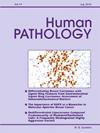Prognostic models for breast cancer: A narrative review
IF 2.6
2区 医学
Q2 PATHOLOGY
引用次数: 0
Abstract
Cancer prognostic models use a combination of risk factors to estimate the probability of patients' clinical outcomes, allowing the physicians to categorize patients into risk groups to guide clinical decision making. An ideal prognostic model would accurately predict patient survival and/or recurrence risk, taking into account a combination of clinical and pathological parameters that are readily available in the standard of care practice, thus can be widely utilized and continuously calibrated. To date, there have been many prognostic models for breast cancer proposed. These models differ in the methods of development and validation, the composition of predicting factors, the projected clinical outcomes, and their utilities. The identification of prognostic factors heavily relies on accurate assessment of pathologic characteristics of tumors, for which the pathologists’ role is essential. Therefore, it is crucial to understand prognostic models in pathology practice to provide more accurate and personalized patient care. Herein, we present a narrative review of commonly used breast cancer prognostic models in clinical practice.
乳腺癌预后模型:叙述性综述。
癌症预后模型使用风险因素的组合来估计患者临床结果的概率,允许医生将患者分类为风险组以指导临床决策。理想的预后模型应能准确地预测患者的生存和/或复发风险,同时考虑到临床和病理参数的组合,这些参数在标准护理实践中很容易获得,因此可以广泛使用并不断校准。迄今为止,已经提出了许多乳腺癌的预后模型。这些模型在开发和验证的方法、预测因素的组成、预测的临床结果和它们的效用方面有所不同。预后因素的确定在很大程度上依赖于对肿瘤病理特征的准确评估,病理学家的作用至关重要。因此,在病理学实践中了解预后模型以提供更准确和个性化的患者护理是至关重要的。在这里,我们提出了一个叙述性的回顾常用的乳腺癌预后模型在临床实践。
本文章由计算机程序翻译,如有差异,请以英文原文为准。
求助全文
约1分钟内获得全文
求助全文
来源期刊

Human pathology
医学-病理学
CiteScore
5.30
自引率
6.10%
发文量
206
审稿时长
21 days
期刊介绍:
Human Pathology is designed to bring information of clinicopathologic significance to human disease to the laboratory and clinical physician. It presents information drawn from morphologic and clinical laboratory studies with direct relevance to the understanding of human diseases. Papers published concern morphologic and clinicopathologic observations, reviews of diseases, analyses of problems in pathology, significant collections of case material and advances in concepts or techniques of value in the analysis and diagnosis of disease. Theoretical and experimental pathology and molecular biology pertinent to human disease are included. This critical journal is well illustrated with exceptional reproductions of photomicrographs and microscopic anatomy.
 求助内容:
求助内容: 应助结果提醒方式:
应助结果提醒方式:


